Abstract
BACKGROUND/OBJECTIVES
While the use of food additives in food processing has become a common practice worldwide, consumers' worry about potential hazards has not diminished. The purpose of this study was to identify trends in South Korean parents' perceptions about food additives by analyzing the results of surveys conducted from 2014 to 2018.
SUBJECTS/METHODS
We conducted an off-line survey in Korea annually between 2014 and 2018 on perceptions about food additives. The numbers of survey respondents in each year from 2014 to 2018 were 381, 426, 301, 519, and 369, respectively. Our consumer respondents were parents of elementary-school-aged children.
RESULTS
The ratios of respondents perceiving “food safety” as the most important factor in purchasing processed foods and “food additives” as the biggest threat to food safety have decreased over the years. However, most consumers still have negative perceptions of food additives. Additionally, among consumers lower confidence in or trust of the Korean government continued throughout the study period and appeared to be the main problem that needs to be overcome.
CONCLUSIONS
This study found that Korean parents are still troubled by food additives. Consumers' confidence in the government needs to be increased through public communications. More multifaceted educational programs communicating scientific knowledge of food additives are needed in order to correct consumers' misperceptions.
Over the last few generations, the food industry has developed, and peoples' eating habits have changed, resulting in an increased number of processed foods on the market [1]. Consumers want tasty, convenient, nutritious and safe foods. To provide food satisfying all those qualities, food processing is indispensable; consequently, food additives are used widely. Food additives extend shelf life, improve the color, texture, and taste of food, provide fortifying nutrients, and facilitate processing conditions [2]. Without food additives, it is impossible to maintain high levels of safety, choice, and convenience of food supply [23].
As food additives became common worldwide, consumers began to worry about potential hazards [34]. The Institute of Food Technologies has highlighted the current misperceptions and misinformation about processed food among consumers in the United States (US) [5], explaining that peoples' uneasiness with food technology, their low scientific literacy, and labeling and advertisements that exploit controversies about food additives or ingredients, are all part of the problem. With continuous improvements in the quality of consumers' lives and the spreading of biased information through mass media in the form of marketing strategies, the demand for all-natural, additive-free foods has steadily increased. Consumers are usually more susceptible to negative than positive information about food additives; therefore, risk communications regarding food additives have been a global issue in advancing their use.
In Korea, several surveys have evaluated the knowledge, recognition, and opinion of consumers toward food additives [678]. A study by Shim et al. [9] emphasized the problem of providing adequate information regarding food additives to the general public. Korean consumer organizations reported on the public's negative perceptions of food additives, as well as a low degree of confidence in the government's control of them [10]. Korean consumers have high-level demands for food safety instructions with reliable information about food additives [111213]. In 2016, the Ministry of Food and Drug Safety (MFDS) changed the classification system for food additives in terms of purpose of use, eliminating the classification of natural or synthetic additives that could confuse or mislead consumers about food additives [14]. This effort aimed to reduce consumers' misconceptions about food additives; however, it seemed not to achieve the desired purpose.
In our previous study [13], we analyzed the trends in Korean children's and parents' perceptions of, and informational needs about, food additives from 2008 to 2013. The results showed that Korean parents perceived food additives as the most dangerous factor among various elements, and their perception had changed little over the survey period. A significant number of Korean parents responded that food additives were more dangerous than food-borne pathogens.
In an effort to assess the safety management of food additives and to provide sound information to consumers, the Korean government, via the MFDS, has been supporting research on food additives annually, conducting consumer surveys as well as developing and providing risk communication materials on food additives through their website and social networking system (SNS). However, the effect of these attempts has not been evaluated. Because Korean consumers still believe food additives to be a major threat to food safety, it is necessary to investigate the changes in perceptions of food additives in order to develop effective risk communication strategies. Therefore, this study aimed to investigate recent trends in Korean consumers' perceptions and informational needs about food additives by analyzing our survey results from 2014 to 2018.
We conducted an annual off-line survey from 2014 to 2018 on the perceptions about food additives and safety. The questionnaires collected from the respondents, who were the Korean parents of elementary school children, were then used for the trend analyses in this study.
In each year from 2014 to 2018, the numbers of survey respondent were 381, 426, 301, 519, and 369, respectively. Consumer respondents were mostly in their 30s and 40s, parents of elementary-school-aged children. Respondents were the residents of Seoul and Gyeonggi province, a central area of Korea, except the respondents in 2017, who ranged across the entire country.
The questionnaire was designed in order to collect data on the perception of Korean parents regarding food additives and safety. The subject of each year's survey varied (“preservatives” in 2014, “antioxidants” in 2015, “bleaching agents” and “color fixatives” in 2016, “food coloring agents” in 2017, and “preservatives” in 2018). However, there were common questions used each year in order to collect ongoing data on the respondents' perceptions on general food additives. Common questionnaire items included the following: 1) the most important factor when purchasing food, 2) factors threatening food safety, 3) the effects of food additive intake on a person's health, 4) the degree of awareness about food additives, 5) the food additive of greatest interest, and 6) the level of confidence in food additive information providers. The factors threatening food safety were measured using multiple-choice questions with options of foodborne pathogens and viruses, food additives, natural toxins, pesticide residues, heavy metals, antibiotics, and environmental pollutants. Some questions, including the effects on a person's health and the degree of awareness, instructed respondents to mark their answer on a 5-point Likert scale, with the weighted value then being used in the analysis (never agree 1, do not agree 2, neutral 3, agree 4, and very much agree 5).
After taking location into consideration in order to achieve an even distribution of samples, we recruited 12–15 classroom teachers from an elementary school in a metropolitan area of Korea to mediate the survey. Most of the mediators were graduate students from the Seoul National University of Education. They informed their students about the survey and asked them to deliver the questionnaire to their parents. Students then delivered the completed surveys to classroom teachers within 2 days. The survey was conducted over a period of 2 months (from March to April) annually from 2014 to 2018. Only those who consented were allowed to participate in the survey. This study was reviewed and approved by the Institutional Review Board (IRB) of the Seoul National University of Education, Seoul, Korea (SNUEIRB-201711-006).
The most important factors in purchasing food were found to be “safety” (39.7%–45.1%), followed by “nutrition” (25.9%–33.8%), “taste” (16.6%–22.5%), and “price” (2.7%–6.6%) (Fig. 1). As parents of young children, responsible for their family's health, respondents were expected to be concerned about food safety [15]. Based on the above results, we confirmed that Korean parents continued to recognize “food safety” as a priority. However, the ratio of respondents who considered “taste” as the most important factor had increased by 5% over 5 years. Meanwhile, the ratio of participants who answered “safety” and “nutrition” had decreased. This trend reflects consumers' increasing interest in gourmet food and more diverse food options.
In 2014, a total of 42.3% of respondents reported that the greatest threat to food safety was “food additives,” while in 2018 the ratio for this factor had decreased to 19.2% and the greatest threat was “environmental pollutants,” as shown in Fig. 2. In reality, the most serious threat to food safety during that time was “foodborne pathogens and viruses”; however, only 19.0%–31.3% of respondents chose that as posing the highest threat to food safety.
As mentioned above, each year we asked about perceptions of the effects of different food additives on health (“preservatives” in 2014, “antioxidants” in 2015, “bleaching agents” and “color fixatives” in 2016, “food coloring agents” in 2017, and “preservatives” in 2018). Although it is difficult to compare each food additive directly, most respondents (56.8%–79.1%) considered each year's food additive to be “hazardous” or “very hazardous” to one's health (Fig. 3). In the case of preservatives, the rate of “hazardous” or “very hazardous” responses decreased by 6.4% over the 4-year period, from 67.7% to 61.3%. Although there is still a high level of negative perception around food additives, we identified that negativity is decreasing slowly over time.
When we asked about people's degree of awareness about each food additive, most respondents (44.3%–57.7%) answered with “neutral,” 14.1%–22.0% of participants answered negatively, and 25.5%–34.7% of participants answered positively (Fig. 4). For preservatives, the number of positive responses increased slightly, from 25.5% in 2014 to 33.4% in 2018. However, the above results revealed the need for proper consumer education on food additives for better understanding of food technology and management of healthier diets.
The food additive people were most interested in was “preservatives” (23.1%–51.6%), followed by “bleaching agents” (11.5%–16.3%), “food coloring agents” (11.6%–13.0%), and “color fixatives” (8.7%–16.3%) (Fig. 5). Interest in preservatives was exceptionally high compared to interest in other food additives.
In terms of people's perceptions of the most reliable sources of information about food additives, the trend had not changed over 5 years (Fig. 6). Respondents' preferences, as measured on a 5-point Likert scale, were in the following order: “universities or research institutes” (3.56–3.74), “hospitals” (3.59–3.74), “non-government organizations (NGOs)” (3.52–3.74), “schools” (3.51–3.60), “the government” (3.21–3.46), “broadcast” (3.18–3.33), “internet websites” (2.57–3.18), and “food companies” (2.51–2.66).
In this study, we investigated changes in Korean parents' perceptions and informational needs about food additives by analyzing results from surveys conducted from 2014 to 2018. We compared these results with those from 2008 to 2013, as well as those from the US Food and Health Survey.
Prioritizing “food safety” had not changed significantly compared with a previous survey from 2008 to 2013 [13]. This trend in Korea was different from that in the US; American consumers rated “taste” (86%), “price” (68%), and “healthfulness” (62%) as the biggest factors in their food purchasing decisions, and the emphasis on “taste” has increased since 2018 [16].
Although the ratio of respondents considering “food additives” to be the greatest threat to food safety has gradually decreased over 10 years, people still consider food additives to be a major food risk factor. With radiation exposure issues in Japan and a significant air pollution problem in Korea, Asian consumers have become particularly concerned about environmental pollutants [17], a concern not shared by US consumers. According to the International Food Information Council Foundation's 2019 Food and Health Survey, American consumers considered “foodborne illnesses from bacteria” the top food safety issue, followed by carcinogens, chemicals in food, pesticides, food additives, animal antibiotics, genetically modified organisms, and allergens, in that order [16]. Song and IM [18] found that Korean consumers believe products with additive-free claims are healthier, overgeneralizing their effects to the extent that consumers believe these products have beneficial aspects beyond those described by additive-free claims (the “halo effect”). The halo effect also works in reverse; although consumers may be aware of the benefits of food additives, they still seem “bad”; respondents in one study felt that food additives should be reduced in all processed foods [19]. Consumers place higher importance on negative information; their willingness to pay for food is more strongly affected by negative than by positive information [2021].
There is still a high level of negative perception among Korean respondents about the effects of food additive intake on health. Similarly, 3 studies conducted in China [222324] showed that Chinese people also had misperceptions about the risks of food additives. In Korea, most consumers have incorrect and negative perceptions about food additives because of information gained through mass media or a lack of proper education, regardless of the type of food additives, such as preservatives, antioxidants, bleaching agents, color fixatives, and food coloring agents. Kim et al. [15] showed that, despite their high concerns about health risks, Korean consumers had little education about food additives. To correct misunderstandings and misperceptions [25], it will be necessary to provide proper information through various risk communication channels. In a review paper on risk/benefit communications about food, recommendations for best practices were that information needs to focus on public demand in relation to existing behaviors and habits, and the associated demographic, phenotypic, and cultural “boundaries” [26].
The degree of awareness of food additives we found suggests that most consumers had heard about food additives but did not have comprehensive knowledge of them. Previous studies also indicated that consumers were unaware of the functions, roles, and advantages of food additives and perceived food additives as unhealthy [927]. Lack of awareness, however, does not imply lack of interest. People were most interested in “preservatives,” a finding in line with the results of our previous survey [13] that identified food preservatives as the perceived most hazardous factor for food safety among Koreans from 2008 to 2013. However, according to the dietary assessment for food preservatives, Koreans' intake level of preservatives was 0.00%–3.01% of the acceptable daily intake in 2008 [28] and 0.59%–0.76% in 2018 [29], meaning that the general Korean intake level of food preservatives is quite low and not worthy of public concern.
Among Korean consumers, lower confidence in, or trust of, the government continued and appeared to be the main problem in need of a solution. People's high confidence in “universities or research institutes” was similar to the results in 2008–2013 [13]; however, the problem of a lower confidence in “the government” than in “hospitals” or “NGOs” was also identified. A previous study showed that NGO members and nutrition teachers had biased perceptions about food additives and little trust in governmental management, which could affect consumers' negative perceptions about food additives [17]. Shim et al. [9] also mentioned that most Korean consumers believed food additives unsafe, although they are approved for use by the government. Conversely, American consumers regarded government agencies as a top source of information in the event of a food recall [16] as well as in the areas of food and health [30]. Wu et al. [24] reported that Chinese people with lower levels of education were more likely than those with higher education levels to purchase foods with additives that follow governmental standards. This reveals that one's educational background may have an influence on the level of trust in governmental institutions regulating food additives. Additionally, Zhong et al. [21] proposed that, in order to lessen widespread consumer worries about food safety, the Chinese government urgently needs to correct understandings about food additives, respond rationally to food-safety incidents, and rebuild confidence in the Chinese food industry. Our results also show the effects of poor risk communication about food additives in Korea; the Korean government should try to increase the trust level of the public and provide more educational opportunities about food additives for consumers, especially parents, who are the most sensitive consumers.
This study showed that Korean parents of elementary school students, consumers highly concerned about food safety, lacked good information about food additives and still worried about them as a major food risk factor. People's low level of trust in the government revealed the necessity of providing better public communication. In order to correct consumers' misperceptions, more multifaceted educational programs within schools and SNS are needed to transmit scientific knowledge about food additives.
Notes
References
1. Nurhan U. Consumer food safety knowledge and practices in the home in Turkey. Food Control. 2007; 18:45–51.

2. Emerton V, Choi E. Essential Guide to Food Additives. Cambridge: Leatherhead Food International, Royal Society of Chemistry;2008. p. 1–21.
3. Branen AL, Davidson PM, Salminen S, Thorngate JH. Food Additives. New York (NY): Marcel Dekker;2002.
4. Bearth A, Cousin ME, Siegrist M. The consumer's perception of artificial food additives: Influences on acceptance, risk and benefit perceptions. Food Qual Prefer. 2014; 38:14–23.

5. Floros JD, Newsome R, Fisher W, Barbosa-Cánovas GV, Chen H, Dunne CP, German JB, Hall RL, Heldman DR, Karwe MV, Knabel SJ, Labuza TP, Lund DB, Newell-McGloughlin M, Robinson JL, Sebranek JG, Shewfelt RL, Tracy WF, Weaver CM, Ziegler GR. Feeding the world today and tomorrow: the importance of food science and technology. Compr Rev Food Sci Food Saf. 2010; 9:572–599. PMID: 33467827.

6. Back BS, Lee YH. Consumer's awareness and policies directions on food additives-focusing on consumer information. J Consum Stud. 2006; 17:133–150.
7. Kim HC, Kim MR. Consumer's recognition and information need about food safety. Korean J Diet Cult. 2001; 16:296–309.
8. Korea Food and Drug Administration. Dietary Intake of Food Additive by Korean Population. Annual Report. Seoul: Korea Food and Drug Administration;2008.
9. Shim SM, Seo SH, Lee Y, Moon GI, Kim MS, Park JH. Consumers' knowledge and safety perceptions of food additives: evaluation on the effectiveness of transmitting information on preservatives. Food Control. 2011; 22:1054–1060.

10. So YJ, Kim S, Lee JH, Park EY, Kim HJ, Kim JS, Kim JW. A survey on the perceptions of consumer organizations to promote risk communication for food additives. Korean J Food Cookery Sci. 2013; 29:105–113.

11. Kim JW. Development educational material for understanding of food additives. Safety Re-evaluation of Food Additives-about 32 Items Contain Colors. KFDA Research Report. Cheongju: Korea Health Industry Development Institute;2013. p. 537–647.
12. Kim KD, Lee JY. A survey on the housewives' purchasing behavior and needs for food safety information. J Korean Soc Food Sci Nutr. 2010; 39:392–398.

13. Kim S, Kim JS, Ko JM, Kim JW. Trends of perception and information needs on food additives of children and parents by analyzing the safety assessment reports of food additives in 2008–2013. Korean J Food Cookery Sci. 2014; 30:249–261.

14. Ministry of Food and Drug Safety. Notification No. 2016-32 [Internet]. Cheongju: Ministry of Food and Drug Safety;2016. cited 2016 April 29. Available from: http://www.mfds.go.kr/index.do?mid=686&seq=10647.
15. Kim S, Kim JS, Kang HJ, Lee G, Lim HS, Yun SS, Kim JW. Changes in Korean consumers' perception on food preservatives by a risk communication booklet. J Food Hyg Saf. 2018; 33:417–426.

16. International Food Information Council (IFIC) Foundation. 2019 Food and Health Survey [Internet]. Washington, D.C.: International Food Information Council;2019. cited 2019 May 22. Available from: https://foodinsight.org/2019-food-and-health-survey.
17. Kang HJ, Kim S, Lee G, Lim HS, Yun SS, Kim JW. Perception gaps on food additives among various groups in Korea: food experts, teachers, nutrition teachers, nongovernmental organization members, and general consumers. J Food Prot. 2017; 80:1015–1021. PMID: 28504615.

18. Song M, IM M. The halo effect of additive-free claims in food and consumer goods. Korean J Consum Advert Psychol. 2016; 17:199–222.
19. Brockman C, Beeren CJ. Additives in dairy foods: consumer perceptions of additives in dairy products. In : Fuquay JW, Fox PF, McSweeney PLH, editors. Encyclopedia of Dairy Sciences. Amsterdam: Academic Press;2011. p. 41–48.
20. Lee JY, Han DB, Nayga RM Jr, Lim SS. Valuing traceability of imported beef in Korea: an experimental auction approach. Aust J Agric Resour Econ. 2011; 55:360–373.

21. Zhong Y, Wu L, Chen X, Huang Z, Hu W. Effects of food-additive-information on consumers' willingness to accept food with additives. Int J Environ Res Public Health. 2018; 15:e2394. PMID: 30380630.

22. Chen S, Lu X, Wu H, Zhong K, Guo L, Zhao J, Luo X. College student's perception of the safety risks of food additives and its main influencing factors. Food Sci. 2014; 35:245–249.
23. Chen S, Wu H, Lu X, Zhong K, Xie X, Li X, Luo X, Guo L. The public's risk perception on food additives and the influence factors. J Chin Inst Food Sci Technol. 2015; 15:151–157.
24. Wu L, Zhong Y, Shan L, Qin W. Public risk perception of food additives and food scares. The case in Suzhou, China. Appetite. 2013; 70:90–98. PMID: 23831014.

25. Rimal A, Fletcher SM, McWatters KH, Misra SK, Deodhar S. Perception of food safety and changes in food consumption habits: a consumer analysis. Int J Consum Stud. 2001; 25:43–52.

26. Frewer LJ, Fischer AR, Brennan M, Bánáti D, Lion R, Meertens RM, Rowe G, Siegrist M, Verbeke W, Vereijken CM. Risk/benefit communication about food-a systematic review of the literature. Crit Rev Food Sci Nutr. 2016; 56:1728–1745. PMID: 25575335.

27. Aoki K, Shen J, Saijo T. Consumer reaction to information on food additives: evidence from an eating experiment and a field survey. J Econ Behav Organ. 2010; 73:433–438.

28. Choi S, Lee J, Park E, Won J, Hong K, Moon G, Kim M, Hong J. Assessment of estimated daily intakes of preservatives in the Korean population. Korean J Food Sci Technol. 2008; 40:503–509.
29. Ministry of Food and Drug Safety. Safety Evaluation of Food Additives. Annual Report. Cheongju: Ministry of Food and Drug Safety;2018.
30. International Food Information Council (IFIC) Foundation. 2014 Food and Health Survey [Internet]. Washington, D.C.: International Food Information Council;2014. cited 2014 April 1. Available from: https://foodinsight.org/2014-food-and-health-survey.




 PDF
PDF Citation
Citation Print
Print



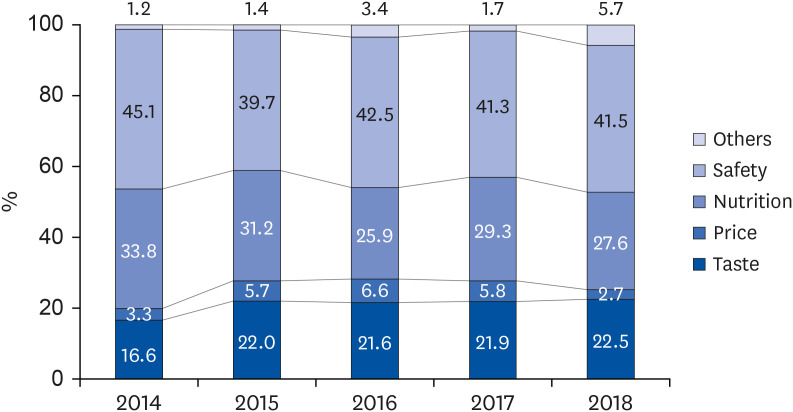
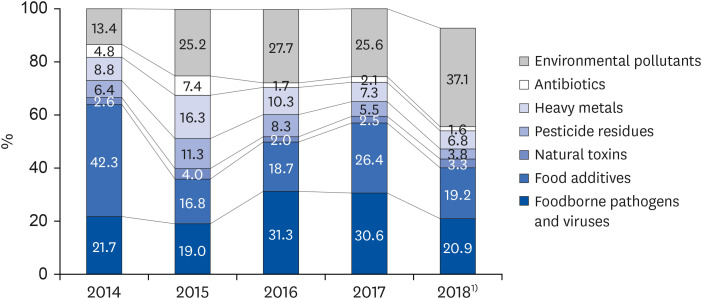
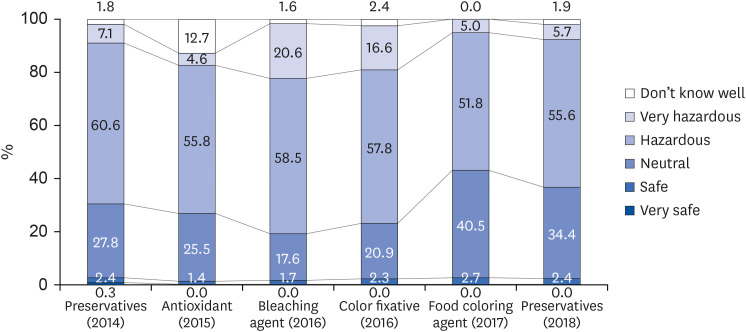
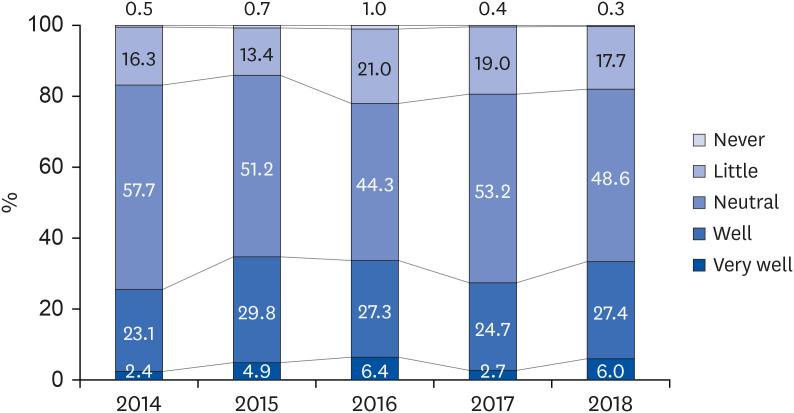
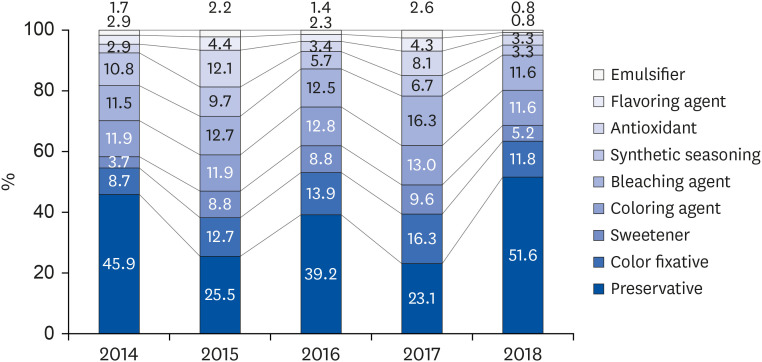
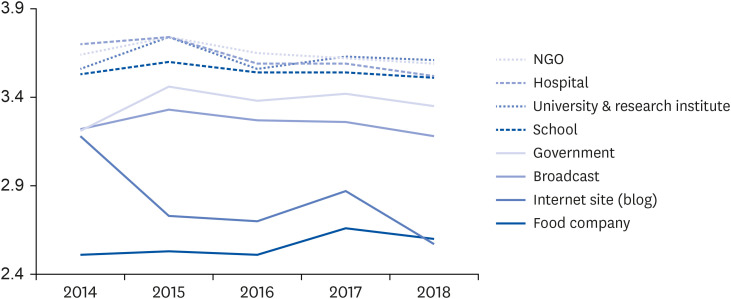
 XML Download
XML Download